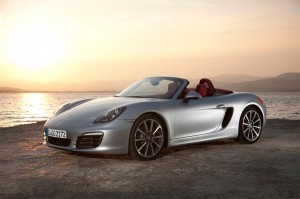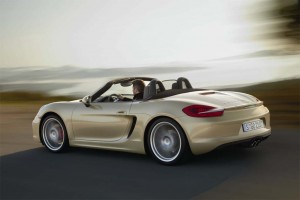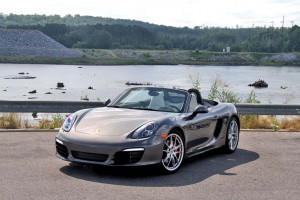Hollywood executives aren’t the only ones who seem to come up with similar ideas all at the same time. When Porsche introduced the original Boxster, back in 1997, it hit market about the same time as several other European roadsters, notably including the Mercedes-Benz SLK and BMW Z3.
The Porsche Boxster was clearly the sportiest of the three – though no one would likely confuse it with the German maker’s classic sports car, the 911. It didn’t have the style, the body stiffness, the power or the performance. It was, by comparison, something of a youthful toy.
To its credit, each successive generation of the Boxster has gotten better and better. And during its unveiling in Geneva, last March, when we asked Porsche chief designer Michael Mauer what the goal was with the all-new model his response was simple: “to make it more mature.” After spending a couple days with the 2013 Porsche Boxster we’d have to say that nails it.
If there’s a downside, it’s something Porsche should worry about. The new model is so solid, so nimble and so attractive that those 911 wannabes who might otherwise have to strain to get into the flagship model might now comfortably enjoy – rather than settle for – the Boxster as an alternative.
The overall look of the 2013 roadster adopts more of a familial look shared with the nearly as-new and well-reviewed 911, notably starting with the distinctive, sloping headlamps. The sculpted side panels, meanwhile, were influenced by the Carrera GT. Codenamed 981, the new Boxster could almost be confused for a 911 if you looked quickly.
Inside, however, you might initially confuse the new Boxster with the Porsche Panamera, especially if you’re focusing on the linked series of circles that form the gauge cluster – including one that displays zoomed in navigation details – or the flat panel of switches surrounding the shifter. Overall, the new Boxster’s cabin shows a level of plush refinement one wouldn’t have expected of even the more expensive 911 not all that many years ago.
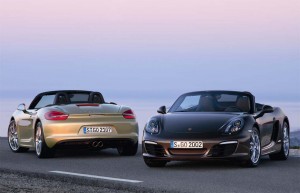
The Boxster will be offered in two configurations, including the S, at least initially, but other variants may be on the way.
Both Boxster and 911 have undergone some major engineering revisions in their latest iterations reflecting Porsche’s increasing emphasis on lightweighting. As with the 911, the new Boxster is bigger than ever, gaining 2.4 inches in wheelbase and 1.3 inches overall. Yet it is also 55 pounds lighter in base trim, while the Boxster S sheds 77 pounds. That required some creative engineering as well as the increased use of steel alternatives, such as a magnesium instrument panel support and lots of aluminum, which now accounts for 47% of the body by weight.
That translates into some surprisingly good mileage numbers, the EPA rating the 2013 Porsche Boxster equipped with a 7-speed dual-clutch automatic at 32 mpg on the highway, a significant 3 mpg boost, with the optional 6-speed stick getting two less.
But that lower weight also clearly translates into an overall improvement in the road manners of the new roadster, especially after Porsche engineers boosted the car’s torsional rigidity by 40% and measurably lowered the new Boxster’s center of gravity. (The roof is also lower by about a half inch.)
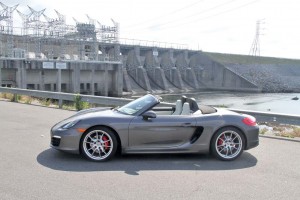
The new Boxster shows the clear visual influence of the 2012 911, with the sides picking up cues from the Carrera GT.
The heart of any Porsche is its powertrain and here the changes for 2013 the base Boxster migrates from a 2.9-liter flat-six to one displacing only 2.7 liters. It’s largely the same engine and, perhaps to a buyer’s pleasant surprise, it makes about 10 more horsepower at 265, thanks to some cylinder-head and exhaust revisions. Torque, however, slips by 7 to 207 pound-feet. That’s still enough to deliver the 5.5-second 0 to 60 times Porsche claims.
Less than perfect stopwatch testing suggested we could trim that by as much as a full second in the Boxster S, with its 315-horsepower 3.4-liter getting us an extra 5 hp for 2013. Torque holds at 266 lb-ft.
During a recent media drive, we heard the usual kvetching and debating about the maker’s decision to go with the 7-speed double-clutch as the 2013 Porsche Boxster’s primary gearbox – and the decision not to adopt, at least as an option, the 7-speed manual introduced on the 2012 Porsche 911. The reality is that the Porsche semi-manual package, known as a PDK, is so good and so quick we just can’t come close to working the stick nearly as efficiently and, when stuck on a busy freeway it gives us the ability to operate in automatic mode, mind-numbing though that might be.
Another debate centers around the new Boxster’s new electro-hydraulic steering system, a concept we first saw introduced with the seventh-gen 911. We fall somewhere in the middle of the discussion. There’s no question it improves fuel economy. And, if anything, we agree with Porsche engineers that they had even more time to tweak and tune the steering system since the 911 rolled out. It is responsive and precise but it doesn’t deliver quite the direct road feel of the classic hydraulic steering box.
The biggest weakness is that there no progressive build-up, you feel the same degree of resistance in a tight, high-speed corner as you do during a moderate-speed, less aggressive turn.
Nonetheless, the overall road manners of the new Boxster are so good that it’s easy to forgive that minor flaw. If anything, the new roadster only encourages more and more aggressive driving, as we discovered during our time behind the wheel both at the Barber race track, near Birmingham, Alabama and some only slightly more leisurely runs through the Deep South countryside. We turned around after charging one particularly challenging up-hill series of tight S-turns to see how much further we could press into the corner before hearing the tires chirp. It took several attempts and even then we were confident we hadn’t come close to the car’s limits.
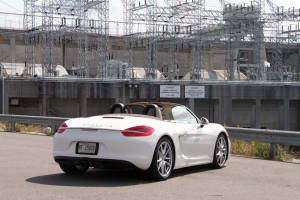
The original 1997 Boxster is given credit for Porsche, which faced serious financial problems at the time.
As you’d expect of anything wearing a Porsche badge, the 2013 Boxster offers a seemingly limitless set of options, such as the Sport Chronos package. That features some intriguing new magnetorheological transmission mounts, which automatically stiffen up when needed, then soften for a more isolated ride when you’re not throttling through corners.
Of course, when you add it all up you’re likely to spend significantly more than you might have first anticipated for the Boxster, which carries a $50,450 base, including delivery charges – the 2013 Porsche Boxster S coming in at $61,850.
Incidentally, as fast as the new Boxster might be, perhaps the quickest action comes when you decide to raise or lower the roadster’s roof – a process now down to a mere 9 seconds.
That’s just one more nice touch in a new model that delivered a pleasant surprise despite whatever minor complaints we might have come up with. The 2013 Porsche Boxster is, indeed, a more refined and refreshing remake of the German maker’s little roadster. Designer Mauer may call it “more mature,” while the folks in Alabama might prefer to say it’s “all growed up.” However you look at it, the results are impressive.

